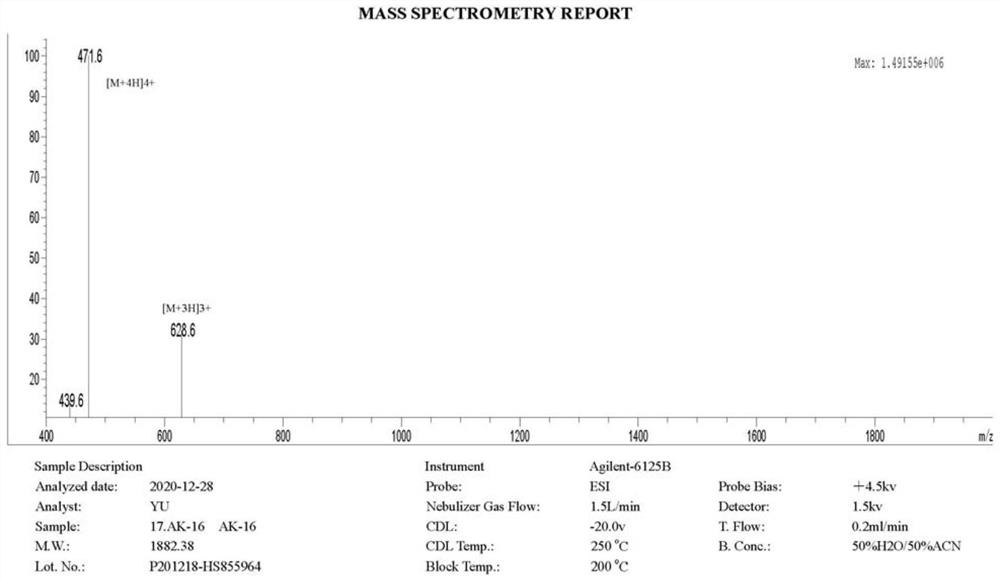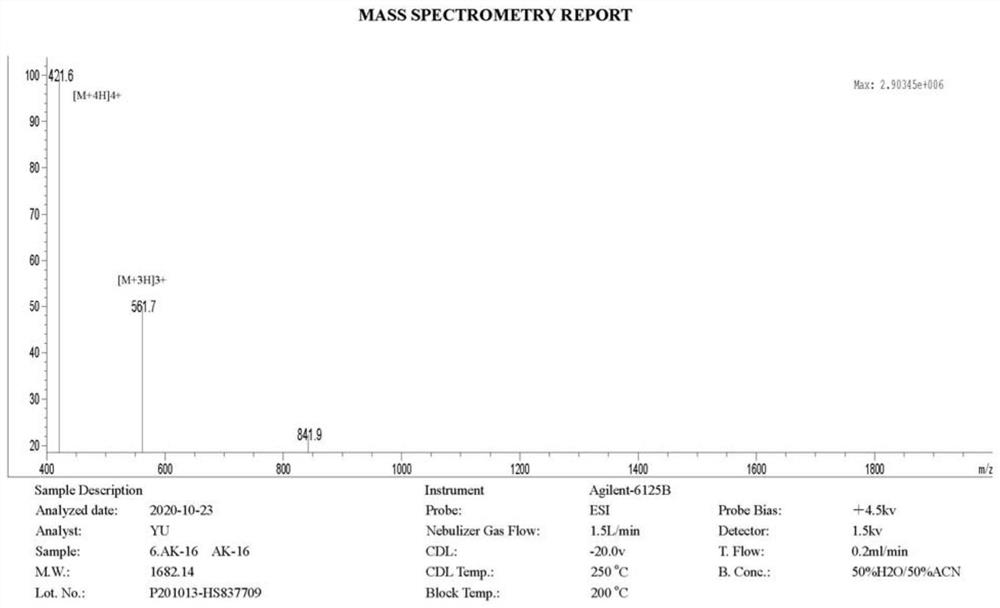I and i+4 site-directed mutation of porcine tp peptide highly active derivative antibacterial peptide and its preparation method and application
A technology of site-directed mutagenesis and antibacterial peptides, which is applied in the preparation methods of peptides, chemical instruments and methods, antibacterial drugs, etc., to achieve the effects of good activity, efficient inhibition, and clear structural characteristics
- Summary
- Abstract
- Description
- Claims
- Application Information
AI Technical Summary
Problems solved by technology
Method used
Image
Examples
Embodiment 1
[0016] Design of Antimicrobial Peptides
[0017] The amino acid sequence of the antimicrobial peptide TP is:
[0018]
[0019] The amino acid sequence of the antimicrobial peptide TP(i+4)1,2 is:
[0020]
[0021] The amino acid sequence of the antimicrobial peptide TP(i+4)5 is:
[0022]
[0023] Using the porcine TP peptide as a template, lysine was used to replace the hydrophilic surface amino acid of the porcine TP peptide at the hydrogen bond formation position (i, i+4), and the amino acids for different pairs were named 1, 2, 3, 4 The best activity is the pair of 1 and 2 that are replaced at the same time. The optimal peptide obtained by charge replacement is named TP(i+4)1, 2. On this basis, tryptophan is used to replace the hydrogen bond formation The amino acid at position (i, i+4) expands the hydrophobic surface of the peptide, and the different pairs of amino acids replaced by tryptophan are respectively named 5, 6, and 7. The activity is best replaced by t...
Embodiment 2
[0028] The above-mentioned antimicrobial peptides were synthesized using a peptide synthesizer. The method was solid-phase chemical synthesis, and the specific steps were:
[0029] 1. The preparation of antimicrobial peptides is carried out one by one from the C-terminal to the N-terminal, and is completed by a peptide synthesizer. First, Fmoc-X (X is the first amino acid at the C-terminal of each antimicrobial peptide) is inserted into Wang resin, and then the Fmoc group is removed to obtain X-Wang resin; then Fmoc-Y-Trt-OH (9 -Fmoxy-trimethyl-Y, Y is the second amino acid at the C-terminus of each antimicrobial peptide); according to this procedure, it is synthesized from the C-terminus to the N-terminus until the synthesis is completed, and the side of the Fmoc group is removed chain protection resin;
[0030] 2. Add a cleavage reagent to the peptide resin obtained above, react in the dark at 20°C for 2 hours, filter; wash the precipitate with TFA (trifluoroacetic acid), m...
Embodiment 3
[0034] Determination of Biological Activity of Antimicrobial Peptides
[0035] Determination of antibacterial activity: The minimum inhibitory concentration of several antimicrobial peptides was determined by the micro broth dilution method. Bacterial single colonies were picked and cultured overnight in MHB medium, and transferred to new MHB to grow to mid-logarithmic phase, diluted to OD600=0.4 before use, and the bacterial solution was diluted 1000 times before use. An equal volume (50 μL) of bovine serum albumin solution (bovine serum albumin solution: BSA 0.2%; 0.01% acetic acid) was added to a 96-well plate. The system in the first row is 90 μL + 10 μL (antimicrobial peptides), the ratio is multiplied to the tenth column, and the final peptide concentration in the 96-well plate ranges from 1 to 128 μM / L. Then add an equal volume (50 μL) of bacterial solution to the 96-well plate. The plates were incubated at 37°C for 18-24 hours. The MIC value is the lowest concentrati...
PUM
 Login to View More
Login to View More Abstract
Description
Claims
Application Information
 Login to View More
Login to View More - R&D
- Intellectual Property
- Life Sciences
- Materials
- Tech Scout
- Unparalleled Data Quality
- Higher Quality Content
- 60% Fewer Hallucinations
Browse by: Latest US Patents, China's latest patents, Technical Efficacy Thesaurus, Application Domain, Technology Topic, Popular Technical Reports.
© 2025 PatSnap. All rights reserved.Legal|Privacy policy|Modern Slavery Act Transparency Statement|Sitemap|About US| Contact US: help@patsnap.com



